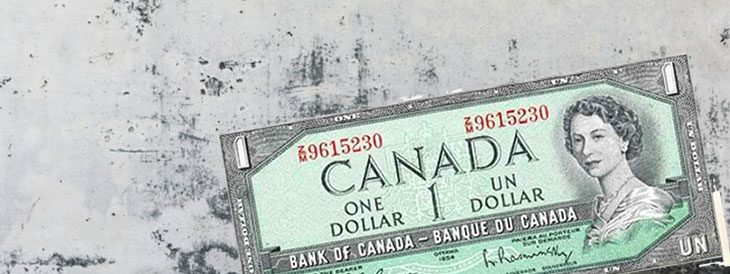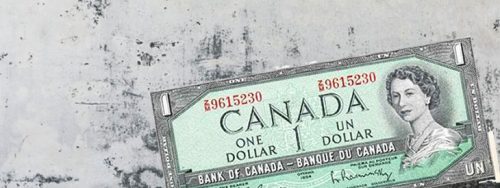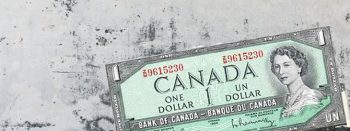Last updated on May 2nd, 2024 at 03:35 pm
Last Updated on May 2, 2024 Posted by Colonial Acres Coins
If you were to ask any collector of money, they would likely tell you that they have a preference for collecting either coins or paper money. While both are widespread hobbies, governments around the world, including the Canadian one, prefer to have more coins in circulation than paper money. The reason for that is the fact that the use of coins is more practical and cost-effective compared to the use of paper money. That is precisely the reason behind the Canadian $1 paper note being discontinued in 1989. Here is everything you need to know about this interesting paper banknote.
WHY THE $1 BILL WAS NO LONGER PRINTED
Back in 1989, the decision was made by the Canadian government to switch from one dollar paper bills to one dollar coins. The reason was the fact that there wasn’t a need to replace coins as frequently as was the case with paper money, as the coins lasted much longer and were able to “suffer” being worn down and handled much more than paper. This means that the Royal Canadian Mint would save a lot of money with such a move.
The Transition Itself
At the time, the “Loonie” – the new dollar coin – had already been in circulation for almost two years. But, the loonie did not garner immediate popularity, partly because of its nickname, which had a mixed reaction from Canadians. Having realized that, the government quickly decided to stop printing the paper dollar bill completely in order to force the shift to the coin. In April of 1989 the presses were brought to a full stop, and in June the issuing of one dollar bills completely stopped. Following this move, the coming months saw banks instead beginning to collect paper one dollar bills from consumers and, in turn, sending them to be destroyed in the central bank. Despite not having been printed or issued since 1989, there are still $151.6 million-worth dollar bills around today.
There are a wide variety of Canadian one-dollar bills. Now that you know the answer to when did Canada stop using 1 dollar bills, it’s helpful to understand the differences between bills from different printing series to know which ones you want to add to your collection. The value of a 1 dollar bill in Canada varies depending on its design and printing date. Below you will find information describing each series plus what design is featured on the front and back of each.
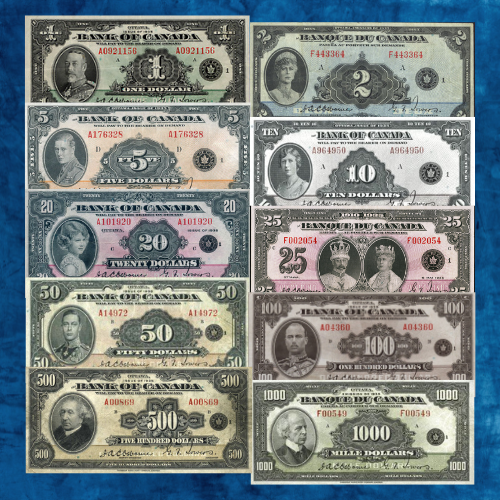 1935 Series
1935 Series
The Bank of Canada was authorized to create banknotes in 1934, and printing started in 1935. Bills from this first series had several security features. Tiny green dots, raised ink and patterns made with fine lines all made it possible to determine if a bill from the 1935 series was real. The design on the backs of each bank note are symbolic Canadian figures that represent the growth of agricultural, industrial, and commercial prosperity.
Pictures of prime ministers and royals were on the front of the banknotes, and although the bills were all unilingual, they were available in either English or French. Interestingly, this series printed bills in $25 and $500 increments.
- 1 Dollar – George V, Agriculture Legend
- 2 Dollar – Queen Mary, Transportation Legend
- 5 Dollar – Edward, Prince of Wales, Electric Power Legend
- 10 Dollar – Princess Mary, Harvest Legend
- 20 Dollar – Princess Elizabeth, Agriculture Legend
- 25 Dollar – King George V and Queen Mary, Windsor Castle
- 50 Dollar – Prince Albert, Duke of York, Modern Inventions Legend
- 100 Dollar – Prince Henry, Duof Gloucester, Commerce and Industry Legend
- 500 Dollar – John A. Macdonald, Fertility Legend
- 1000 Dollar – Wilfred Laurier, Security Legend
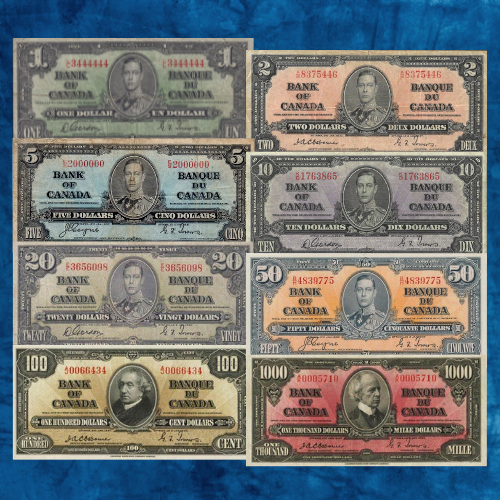 1937 Series
1937 Series
Just two years after launching its first series of banknotes, the Bank of Canada started printing its second series. It happened so quickly because Canadian officials passed legislation requiring all banknotes to be bilingual with both French and English writing.
The security features were the same as those for the first series. The design had a distinct colour variation from the first series of banknotes, and while the back of the banknote featured the same basic design as that of the first banknotes, the front featured a centralized portrait of King George VI on most denominations. For banknotes in denominations of $100 and $1,000, the picture of the royal was replaced with portraits of Canadian prime ministers.
- 1 Dollar – King George VI, Agriculture Legend
- 2 Dollar – King George VI, Harvest Legend
- 5 Dollar – King George VI, Electric Legend
- 10 Dollar – King George VI, Transportation Legend
- 20 Dollar – King George VI, Fertility Legend
- 50 Dollar – King George VI, Modern Inventions Legend
- 100 Dollar – John A. Macdonald, Commerce and Industry Legend
- 1000 Dollar – Wilfred Laurier, Security Legend
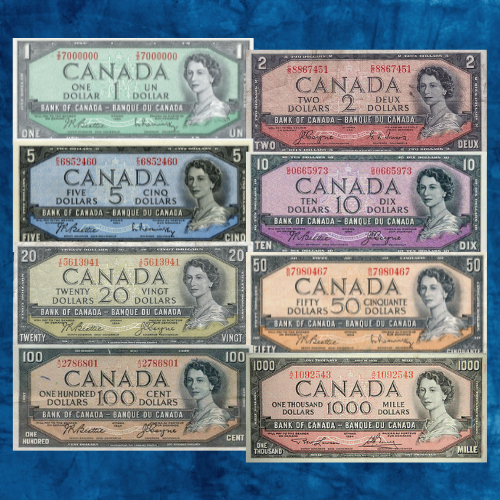 1954 Series
1954 Series
The third series of Canadian banknotes did away with two of the security features used for the first two series. The raised ink feature, however, proved to be so effective that the third series of banknotes was made with raised ink on both sides of the paper. Every banknote had black ink on the front, and the ink on the back has a different hue depending upon the banknote’s denomination.
The overall design was similar to those from earlier series in that the 1954 series banknotes featured a portrait of the Queen. A small error in the original printing caused part of the Queen’s hair to resemble a smiling devil, so in 1956, the series was modified to eliminate the issue with the printing plates.
This series was the first to include Canada’s coat of arms in the background design. It also used simple lines instead of elegant patterns, and the portrait of the Queen on the front moved to the right of the note.
To mark the centennial of the Canadian Confederation in 1967, a special $1 note was issued. Its design was based on the 1954 version but featured the original Parliament buildings on the back, the Centennial maple leaf logo on the front and special text at the top and bottom. Some featured the dates “1867 1967” in place of the serial number.
- 1 Dollar – Queen Elizabeth II, Saskatchewan Praire
- 2 Dollar – Queen Elizabeth II, A Country Scene in Richmond Quebec
- 5 Dollar – Queen Elizabeth II, Otter Falls, (Aishihik River), Yukon
- 10 Dollar – Queen Elizabeth II, Mount Burgess, British Columbia
- 20 Dollar – Queen Elizabeth II, Winter landscape, Laurentian Mountains, Quebec
- 50 Dollar – Queen Elizabeth II, Lockeport Beach, Nova Scotia
- 100 Dollar – Queen Elizabeth II, Okanagan Lake, Munson Mountain, British Columbia
- 1000 Dollar – Queen Elizabeth II, L’Anse-Saint-Jean, Quebec
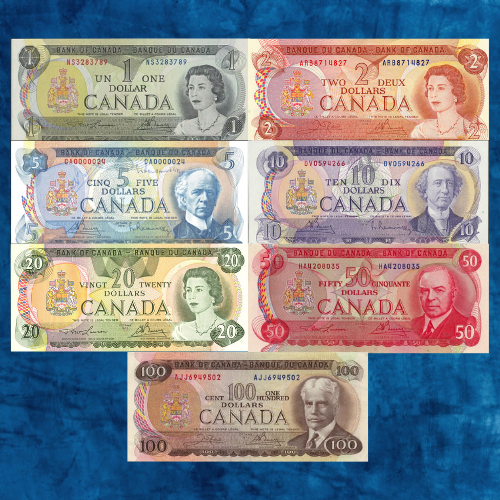 1969-1979 Scenes of Canada
1969-1979 Scenes of Canada
By 1969, the raised ink used as a security feature from the first three series of banknotes was no longer an effective way to identify true currency from counterfeit banknotes. The Bank of Canada decided to launch a new series. This time, the banknotes were multicoloured and blended two hues, which made the notes much harder to duplicate.
The banknotes from this multicoloured series featured various landscapes of Canada. The bills were designed to display and honour the beauty of the Canadian countryside.
In this series, it is important to mention that the $1 note wasn’t issued until June 1974 and would be the last one-dollar note issued by the bank. With the $1 coin (the Loonie) being introduced in 1987 the issuing of the paper money ended in 1989. This means that the most recent one-dollar banknotes are more than 30 years old, making them a great item for collectors.
- 1 Dollar – Queen Elizabeth II, Tugboat on the Ottawa River below Parliament Hill
- 2 Dollar – Queen Elizabeth II, Inuit Hunting Scene based on a photo taken by Doug Wilkinson at Pond Inlet on North Baffin Island.
- 5 Dollar – Sir Wilfrid Laurier, Salmon seiner in the Johnstone Strait, northeast of Vancouver Island.
- 10 Dollar – Sir John A Macdonald, Polymer Corporation in Sarnia, Ontario
- 20 Dollar – Queen Elizabeth II, View of Moraine Lake in Alberta’s Valley of the Ten Peaks
- 50 Dollar – Prime Minister William Lyon Mackenzie King, The dome formation from the RCMP musical ride
- 100 Dollar – Prime Minister Sir Robert Borden, Harbour at Lunenburg, Nova Scotia
Collectors Items?
After it was announced that the $1 bill would no longer be printed, many Canadians started hoarding them in the hopes that they would increase in value. They were advised against such actions, though, and the reason for that was that there were millions of these bills in circulation. On the other hand, people were able to purchase uncut sheets of dollar bills for the sake of sentimental value. Priced at $50 each, the uncut sheets that continued to be sold ended up worth nearly $3-million in value.
LOOKING TO GET YOUR $1 APPRAISED? HEAD DOWN TO COLONIAL ACRES
If you’re a paper money collector and are looking to either get your collection appraised fairly or find new and interesting paper money pieces to enrich it at the same time, check out Colonial Acres Coins. Colonial Acres has been in business for well over two decades and is home to industry experts who won’t shy away from offering expert knowledge and information on all things numismatics-related, not to mention truly rare and eye-catching paper money specimens. Head down to Colonial Acres Coins and find cool pieces to add to your collection today.

